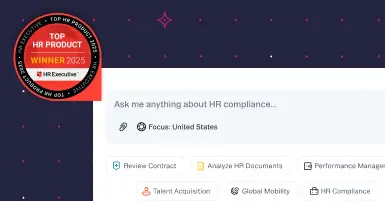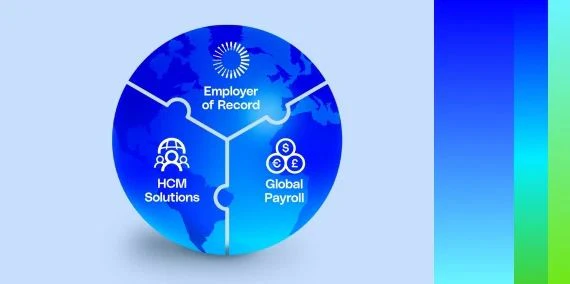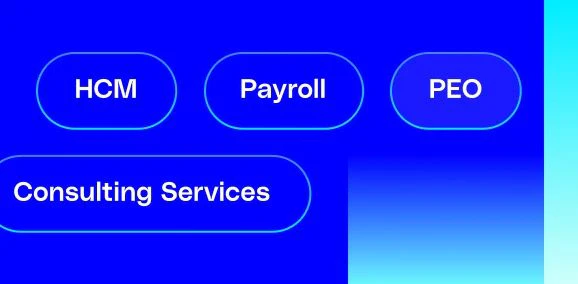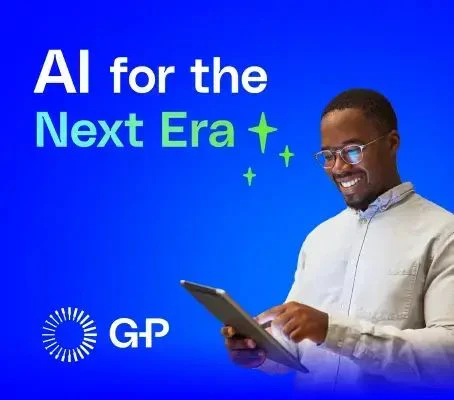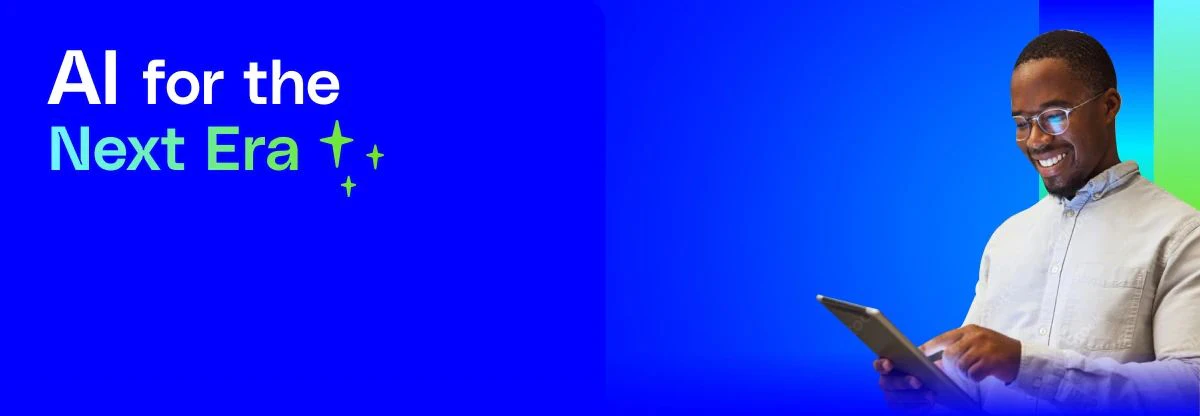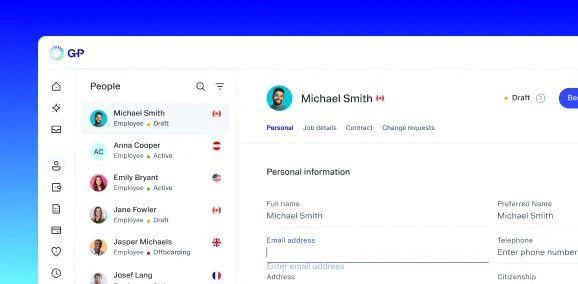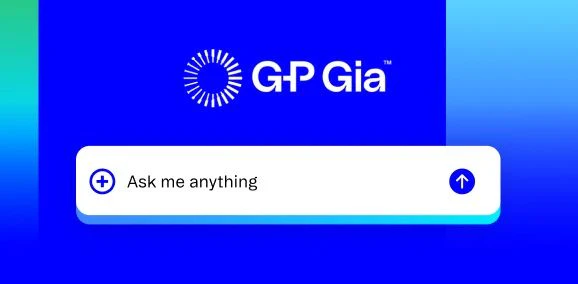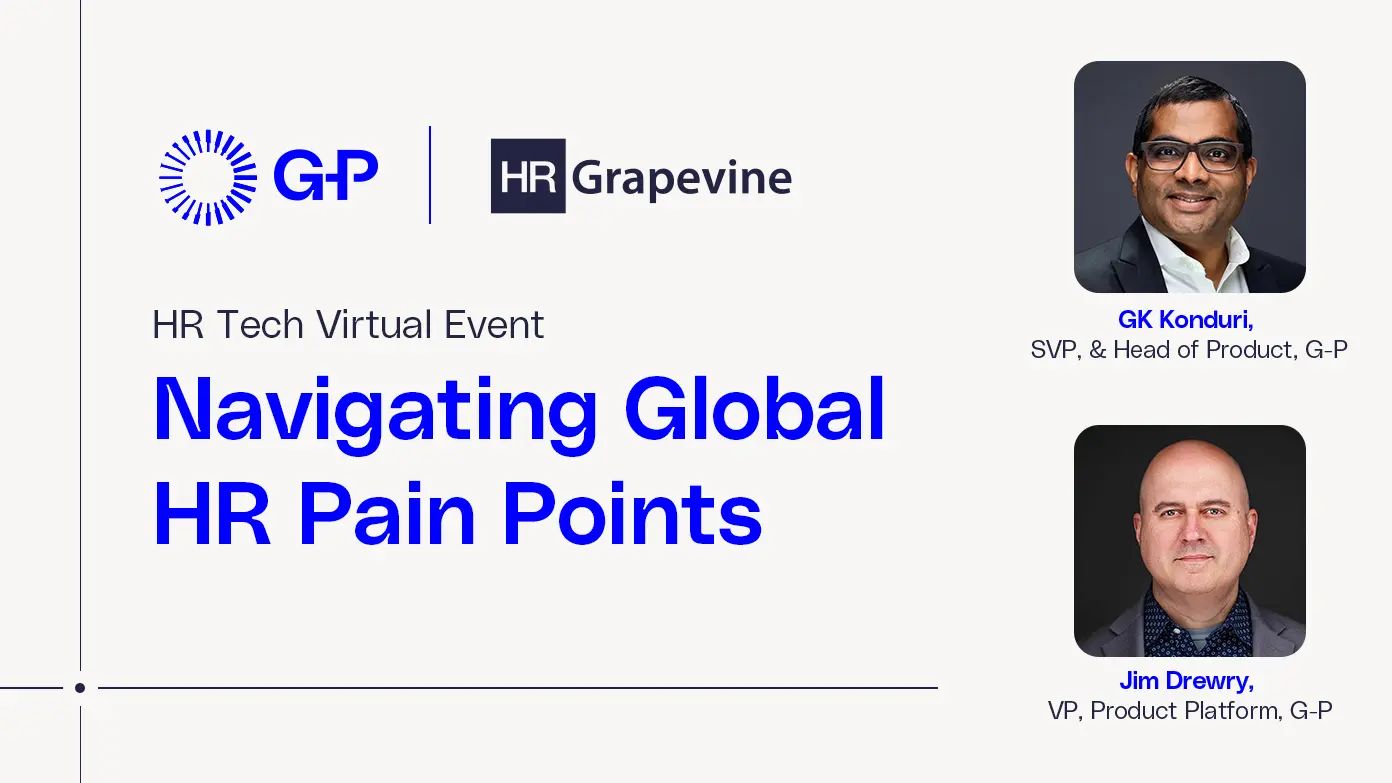G-P’s 2025 World at Work report, which gathered insights from 6,000 global business leaders and professionals, found that 84% of executives find it difficult to hire skilled talent in existing markets. Companies today need to look beyond local talent pools and this global hiring challenge no longer falls solely on your CHRO. It impacts the entire organization. Global hiring takes time, money, and coordination across legal, finance, IT, and HR. With so many elements involved, one delay can cause major setbacks.
G-P™ colleagues GK Konduri, SVP and Head of Product, and Jim Drewry, VP of Product Platform, recently sat down to discuss common global hiring challenges and how innovative AI solutions can solve them. Here are the top four most common global hiring challenges they discussed:
Challenge #1: If you don’t know where to start with global hiring
There are many reasons to grow your company beyond borders. For example, accessing top global talent you can’t find locally. According to G-P’s 2024 World at Work report, local talent shortages were the #1 roadblock to company growth for 41% of executives. Knowing where to find the right talent is a big pain point for HR teams today.
The right technology can simplify things. Our AI-powered global HR agent, G-P Gia™, “can answer all of your questions and give you guidance from day one on your global expansion plans,” says Konduri.
Pairing innovative HR tech like Gia with an employer of record (EOR) like G-P is the quickest and easiest path to effortless global hiring. “G-P has HR legal specialists in all the countries where we do business,” Drewry says. “They're guiding you on these norms, cultural practices, and the best practices for how to handle sensitive situations [when hiring globally].” With G-P, you get a blend of human expertise and AI technology to hire confidently anywhere in the world.
Challenge #2: If you don’t have the time or the funds to set up a legal entity
Costs add up quickly when you establish your own entity in a new market. It can take over 12 months to open a subsidiary in some countries. This can impact your speed-to-market goals and drain your resources. Costs include everything from legal and professional fees to minimum capital requirements. But Konduri notes that the biggest cost isn't monetary. "The business can't expand into global markets until all these things are resolved. And that is the real bigger cost.”
This is where partnering with an EOR can help. An EOR provider has already done the legwork and has an established global entity infrastructure you can use. They’re familiar with the local landscape in your target location, so you can start hiring without the cost and complexity of entity setup. “You can hire in new markets in weeks rather than months, and stay compliant,” says Konduri. And if you also need contractors for specialized projects, G-P Contractor™ handles everything from contracts and misclassification protection to invoices and payments in 190+ countries and 130+ currencies.
Employees are often misclassified as contractors because global employment laws are complex, and this can be a big financial risk. But our Classification Engine uses AI to check contracts and find wording that shows a contractor is operating as an employee, and provide guidance on what to change. As well as avoiding fines, you’ll save time and money by letting AI do the hard work instead of waiting on outside counsel.
Challenge #3: If you don’t know how to onboard global employees
Onboarding a new employee involves figuring out compliance requirements. An onboarding checklist can make sure new employees have the right to work, the necessary visas, and the correct benefits. Because these rules differ by country and are constantly changing, tracking compliance manually is time-consuming and potentially fraught with errors.
Drewry explains how EOR partners like G-P can reduce risks and streamline workflows. AI tools build logic into a platform, preventing users from being in breach of compliance laws. “We have a product feature called Global Compliance Engine (GCE) and it runs behind the scenes,” he says. “So every screen you interact with, where we’re collecting data or transforming data within the G-P platform, is connected with this GCE to make sure everything is done in compliance with the current regulations.”
“The global compliance engine has these rules across all 180+ countries and markets, and even goes down to the level of the state and even the CBA area,” Konduri adds.
Challenge #4: If you don’t know how to handle ongoing compliance monitoring
Operating globally means you have to deal with frequent changes in employment laws. If you’re operating in multiple countries at once, staying on top of it all can turn into a real headache. According to Drewry, compliance is a complex issue that involves far more than just employee costs, like managing insurance risk.
He summarizes the cognitive load that you and your team will carry. "Compliance is a complex area that's always in flux. So just because you're compliant today doesn't mean you're compliant tomorrow, and that's why it's best to partner with someone who can help you handle ongoing, proactive compliance monitoring.”
Compliance-related work can make or break your global hiring plans. AI can take off the pressure. For instance, Gia provides instant, expert guidance that simplifies HR tasks. Gia’s built on over a decade of our proprietary global employment expertise. And, with G-P Verified, it’s the only AI backed by 100,000+ legally vetted articles and 1,500+ government sources to ensure compliance. Gia delivers trusted guidance so you can manage global HR with speed, clarity, and confidence. Is your team ready to simplify global compliance? With Gia, it’s done.
Want the full webinar? Watch now.
G-P’s 2025 World at Work report, which gathered insights from 6,000 global business leaders and professionals, found that 84% of executives find it difficult to hire skilled talent in existing markets. Companies today need to look beyond local talent pools and this global hiring challenge no longer falls solely on your CHRO. It impacts the entire organization. Global hiring takes time, money, and coordination across legal, finance, IT, and HR. With so many elements involved, one delay can cause major setbacks.
G-P™ colleagues GK Konduri, SVP and Head of Product, and Jim Drewry, VP of Product Platform, recently sat down to discuss common global hiring challenges and how innovative AI solutions can solve them. Here are the top four most common global hiring challenges they discussed:
Challenge #1: If you don’t know where to start with global hiring
There are many reasons to grow your company beyond borders. For example, accessing top global talent you can’t find locally. According to G-P’s 2024 World at Work report, local talent shortages were the #1 roadblock to company growth for 41% of executives. Knowing where to find the right talent is a big pain point for HR teams today.
The right technology can simplify things. Our AI-powered global HR agent, G-P Gia™, “can answer all of your questions and give you guidance from day one on your global expansion plans,” says Konduri.
Pairing innovative HR tech like Gia with an employer of record (EOR) like G-P is the quickest and easiest path to effortless global hiring. “G-P has HR legal specialists in all the countries where we do business,” Drewry says. “They're guiding you on these norms, cultural practices, and the best practices for how to handle sensitive situations [when hiring globally].” With G-P, you get a blend of human expertise and AI technology to hire confidently anywhere in the world.
Challenge #2: If you don’t have the time or the funds to set up a legal entity
Costs add up quickly when you establish your own entity in a new market. It can take over 12 months to open a subsidiary in some countries. This can impact your speed-to-market goals and drain your resources. Costs include everything from legal and professional fees to minimum capital requirements. But Konduri notes that the biggest cost isn't monetary. "The business can't expand into global markets until all these things are resolved. And that is the real bigger cost.”
This is where partnering with an EOR can help. An EOR provider has already done the legwork and has an established global entity infrastructure you can use. They’re familiar with the local landscape in your target location, so you can start hiring without the cost and complexity of entity setup. “You can hire in new markets in weeks rather than months, and stay compliant,” says Konduri. And if you also need contractors for specialized projects, G-P Contractor™ handles everything from contracts and misclassification protection to invoices and payments in 190+ countries and 130+ currencies.
Employees are often misclassified as contractors because global employment laws are complex, and this can be a big financial risk. But our Classification Engine uses AI to check contracts and find wording that shows a contractor is operating as an employee, and provide guidance on what to change. As well as avoiding fines, you’ll save time and money by letting AI do the hard work instead of waiting on outside counsel.
Challenge #3: If you don’t know how to onboard global employees
Onboarding a new employee involves figuring out compliance requirements. An onboarding checklist can make sure new employees have the right to work, the necessary visas, and the correct benefits. Because these rules differ by country and are constantly changing, tracking compliance manually is time-consuming and potentially fraught with errors.
Drewry explains how EOR partners like G-P can reduce risks and streamline workflows. AI tools build logic into a platform, preventing users from being in breach of compliance laws. “We have a product feature called Global Compliance Engine (GCE) and it runs behind the scenes,” he says. “So every screen you interact with, where we’re collecting data or transforming data within the G-P platform, is connected with this GCE to make sure everything is done in compliance with the current regulations.”
“The global compliance engine has these rules across all 180+ countries and markets, and even goes down to the level of the state and even the CBA area,” Konduri adds.
Challenge #4: If you don’t know how to handle ongoing compliance monitoring
Operating globally means you have to deal with frequent changes in employment laws. If you’re operating in multiple countries at once, staying on top of it all can turn into a real headache. According to Drewry, compliance is a complex issue that involves far more than just employee costs, like managing insurance risk.
He summarizes the cognitive load that you and your team will carry. "Compliance is a complex area that's always in flux. So just because you're compliant today doesn't mean you're compliant tomorrow, and that's why it's best to partner with someone who can help you handle ongoing, proactive compliance monitoring.”
Compliance-related work can make or break your global hiring plans. AI can take off the pressure. For instance, Gia provides instant, expert guidance that simplifies HR tasks. Gia’s built on over a decade of our proprietary global employment expertise. And, with G-P Verified, it’s the only AI backed by 100,000+ legally vetted articles and 1,500+ government sources to ensure compliance. Gia delivers trusted guidance so you can manage global HR with speed, clarity, and confidence. Is your team ready to simplify global compliance? With Gia, it’s done.


